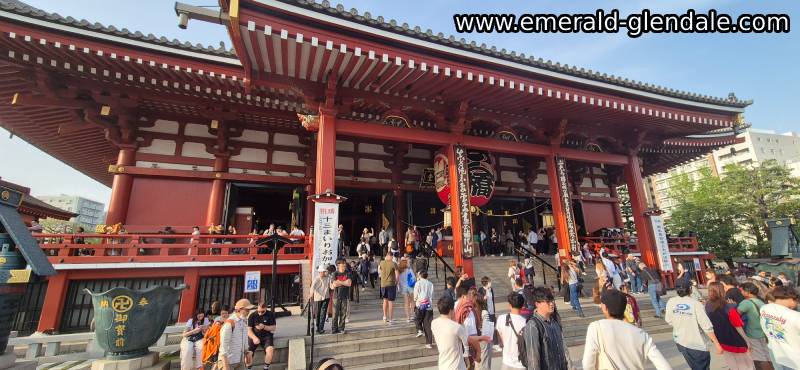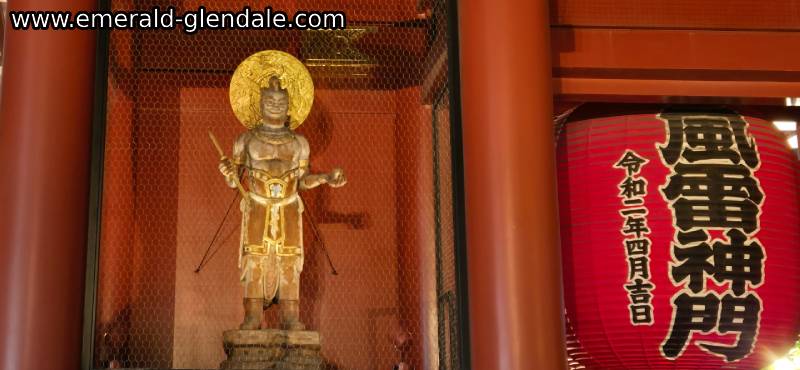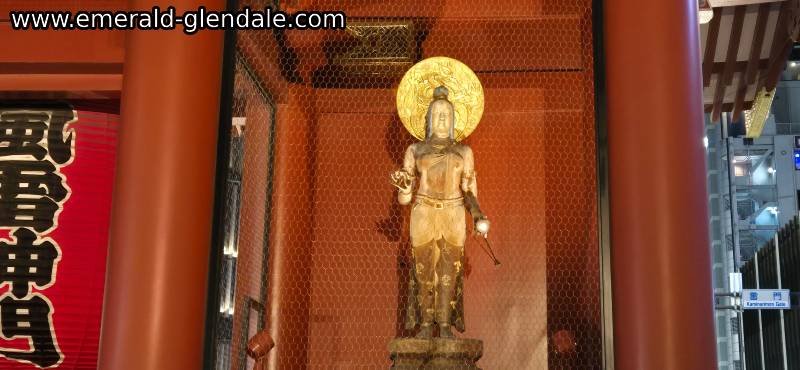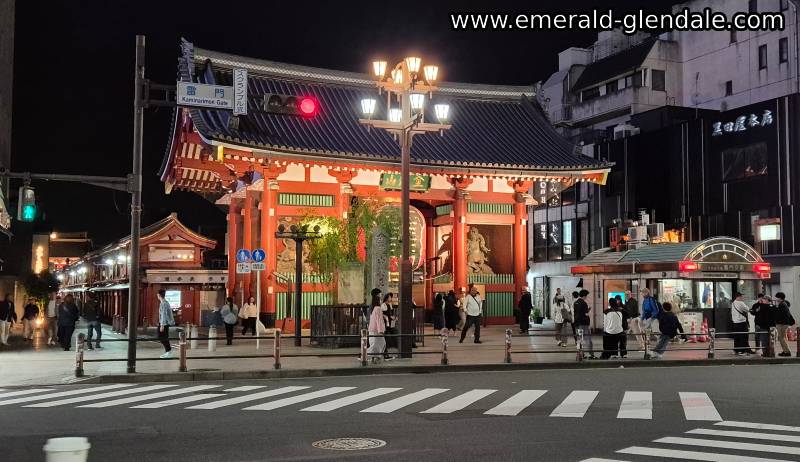Asakusa Kannon Senso-ji Buddhist Temple
Introduction
The Sensoji temple 浅草寺, also known as Asakusa Kannon 浅草観音, is an ancient Buddhist temple in Tokyo's Asakusa area. It is the city's oldest and one of Japan's most popular Buddhist temples. It is a vital center of Buddhism that attracts about 30 million visitors yearly.
Story of Tokyo's Oldest Temple
In the year 628, two brothers, Takenari Hinokuma 檜前竹成 and Hamanari Hinokuma 檜前浜成, were fishing on the Sumida River 隅田川. One day, they heard a divine command from the heavens to cast their nets. When they pulled them in, they discovered a golden statue. When they returned to their village, which is nowadays Asakusa, they showed the statue to the village headman Nakatomo Hajino 土師中知, and he realized the brothers found a statue of Avalokitesvara Bodhisattva 聖観世音菩薩, also known as Kannon 観音. The sight of the statue moved the village headman so much that he became a devoted follower of Bodhisattva Kannon, dedicating the rest of his life to Buddhist practice and faith. He took vows as a Buddhist priest and turned his house into a temple to worship Kannon. This event marks the birth of Tokyo's oldest temple and the start of Sensoji's history.
In the year 645, a notable Buddhist priest with the name Shokai 勝海 came to Asakusa 浅草 and built a hall for the worship of Bodhisattva Kannon, making him the official founder of the Sensoji temple. After having a mysterious dream at night, Shokai decided that the Bodhisattva Kannon statue must be hidden from human view and is still to this day. People heard of the Bodhisattva Kannon, and the words of blessing attracted people from all over Japan. As a result, Asakusa 浅草 started to flourish and became an important district of Tokyo.
Somewhere in the mid-ninth century, the head and highest priest of the Enryaku-ji temple 延暦寺 of the Tendai school of Buddhism 天台宗, named Ennin (794-864) 圓仁 visited the Sensoji temple. He created a statue of Bodhisattva Kannon identical to the hidden statue. Ennin helped develop Sensoji, which started to attract devout Bhuddists, samurai, and persons of culture. During the Edo shogunate and under the rule of shogun Tokugawa Ieyasu (1542-1616) 徳川家康, Sensoji reached its peak of prosperity. For centuries after this day, the temple has remained a center of culture and worship in Tokyo, with millions of visitors every year. It's one of Japan's most familiar temples.
Meaning of Senso and Asakusa
Senso and Asakusa have the same meaning: shallow grass; the only difference is that Senso is the Chinese pronunciation while Asakusa is the Japanese.
Destruction during the Second World War
During the American firebombing raid on March 10, 1945, the temple sustained significant damage, with the Hondō main hall (本堂) completely destroyed by fire. Between 1951 and 1958, the main hall was rebuilt. They rebuilt the Kaminarimon Gate (雷門) in 1960, the Hozomon Gate (宝蔵門) in 1964, and the Five-story Pagoda (五重塔) in 1973.
Kaminarimon Gate 雷門
The Kaminarimon Gate 雷門 means "thunder gate," is located at the beginning of the processional road leading to Sensoji 浅草寺. It is the most famous landmark in Asakusa 浅草.
In the middle of the gate is a large lantern inscribed with the Japanese Kanji characters for "thunder gate" 雷門 on it. Donated by a Kyoto 京都 latern maker, it has a height of around 4 meters (13 feet) and weighs around 700 kg (1544 lbs). Don't forget to check the bottom of the lantern! Artisans carved a beautiful dragon into the wood.
On the front side of the gate, two wooden statues are enshrined of Buddhist gods. You can find Fujin 風神, the God of Wind on the right side. And you can discover Raijin 雷神, the God of Thunder, on the left side. Both gods gave their names to the gate. People pray to these gods to protect the temple against fire, floods, and storms.
On the back side of the gate, two wooden Buddhist statues are enshrined. On the left side, you can find Ten-Ryu 天龍, a male dragon spirit, and on the right side Kin-Ryu 金龍, a female dragon spirit.
These statues protect the temple against future fires. The artisans Denchu Hiragushi 平櫛田中 and Yasuo Sugawara 菅原安男 carved the statues from Kiso cypress wood in 1978. Ten-Ryu 天龍 wears a waist armor of leather and holds a weapon named Tokkosho 独鈷杵 in his right hand and a gold prayer bead in his left hand. The statue is 2.93 meters high and weighs around 250 kg (550 lbs). Kin-Ryu 金龍 wears an inner garment and holds a silver prayer bead in her left hand. The statue is 2.74 meters high and weighs around 200 kg (440 lbs).
The gate was erected in 942 but burned down several times in the last centuries. The gate last burned down in 1865 and was finally rebuilt in 1960 and financed by Japanese entrepreneur Konosuke Matsushita 松下幸之助 (1894-1989) of Panasonic.
Sanja Matsuri Festival 三社祭
The translation of Sanja Matsuri means "Three Shrine Festival" and is a Shinto festival held annually on the third Friday, Saturday, and Sunday of May. The festival is in honor of the spirits of the three founders of the Sensoji temple: the fishermen brothers Takenari Hinokuma 檜前竹成, Hamanari Hinokuma 檜前浜成, and village head Nakatomo Hajino 土師中知. See Story of Tokyo's Oldest Temple for more information.
Location of the Temple
The temple is located on the northeast side of Tokyo, next to the Sumida River 隅田川 in the Asakusa District within the Taito Ward 台東区. See the exact location in the Google Maps below.
Tips on Visiting the Temple
The temple grounds can be very crowded during the daytime, especially on weekends. We recommend visiting the temple during the daytime, as the main hall is open until 5 PM. Souvenir shops are on the Nakamise Shopping Street 仲見世通りa promenade towards the main hall. The opening hours of the shops are between 9 AM and 6-7 PM. We also recommend visiting the temple during the evening to enjoy the fascinating photogenetic illuminated buildings.
Admission Fee & Opening Hours
The temple grounds are free to visit and accessible 24 hours daily. The main hall has specific opening hours: 6 AM to 5 PM from April to September and 6:30 AM to 5 PM from October to March.
How to Get There
The fastest and most convenient way to visit the Sensoji temple is by subway. Asakusa Station 浅草駅 is close to the temple and has two underground stations. The south part of the station is the end station of the Tokyo Ginza Subway Line 銀座線 (station number 19) and is operated by Tokyo Metro. The line is recognizable by its orange color and is Asia's oldest subway line. It officially opened on December 30, 1927. The Ginza Line starts in Shibuya 渋谷駅 (station number 01), and you can transfer to this line from the JR Yamanote Line at Shimbashi 新橋駅 or Ueno 上野駅 Station. At the north part of the station, the second metro line stops: the Asakusa Line 浅草線, operated by Toei Subway. The line is recognizable by its salmon color and consists of 20 stations, from which Asakusa is station number 18.
Address & Phone Number
Address: 2 Chome-3-1 Asakusa, Taito City, Tokyo 111-0032
Phone Number: 03-3842-0181
Official Website
Visit the official website of the temple over here:
Official Website



